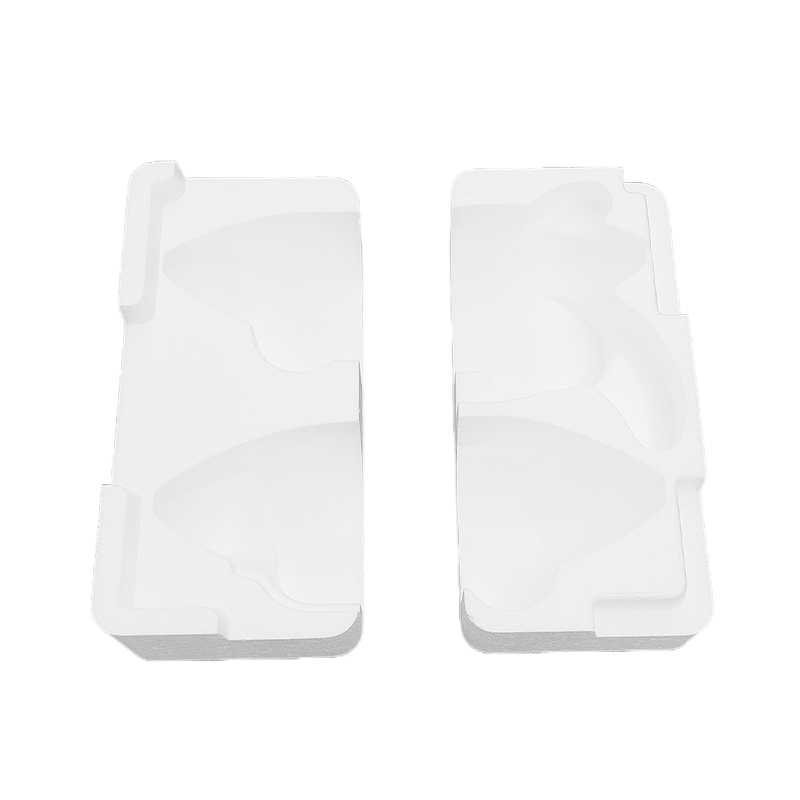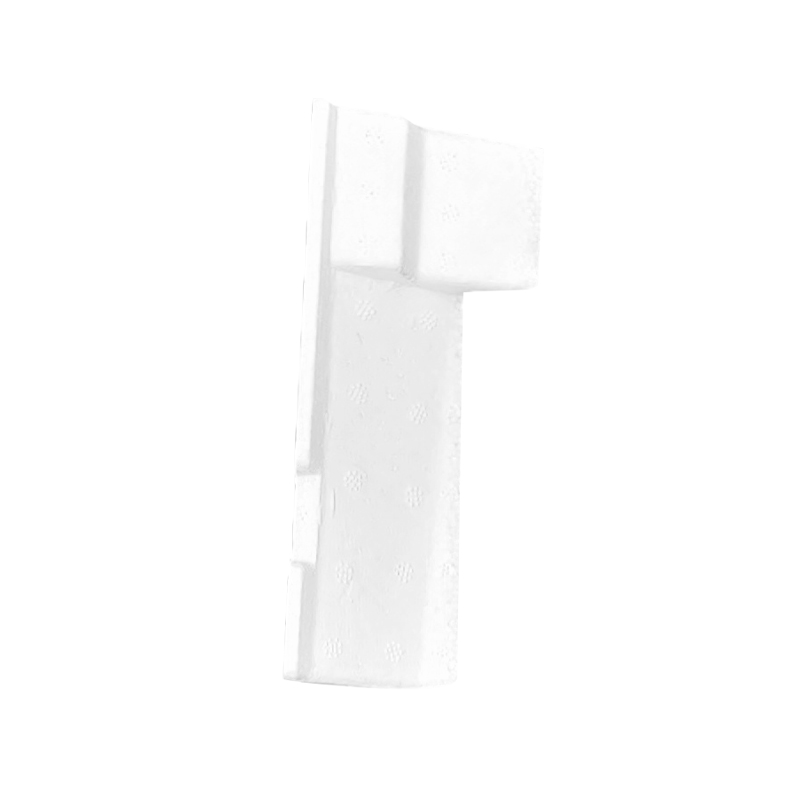How can EPS filler cleverly utilize its structure to achieve comprehensive, tight-fitting protection for the highly irregularly shaped and vulnerable parts of household appliances?
Release Time : 2025-11-12
In today's booming modern logistics and e-commerce landscape, the safe transport of household appliances has become a core concern for manufacturers, logistics providers, and consumers. Especially for large, complex appliances such as televisions, refrigerators, washing machines, and air conditioners, which contain delicate or fragile components like glass panels, compressors, and control circuits, irreversible damage can easily occur if they encounter vibration, collisions, or drops during transport. As a "classic guardian" in the packaging cushioning field, EPS filler, with its advantages of being lightweight, highly energy-absorbing, and easily moldable, demonstrates outstanding engineering wisdom in protecting the vulnerable parts of irregularly shaped appliances—achieving "tailor-made" comprehensive, tight-fitting protection through precise structural design.
1. Personalized Structural Modeling Based on Product Characteristics
EPS filler is not a one-size-fits-all foam block, but rather a customized product manufactured after reverse engineering and 3D modeling based on the specific shape of each appliance. The designers first analyze the product's shape, center of gravity distribution, and key vulnerable points: for example, the ultra-thin screen edge of an LCD TV, the suspension bracket of a refrigerator compressor, and the glass cover of a washing machine control panel. Then, corresponding grooves, bosses, snap-fit elements, and wraparound edging structures are precisely constructed in the EPS mold. These structures act like a "second skin," ensuring a perfect fit between the foam cavity and the appliance surface, leaving no gaps. Once the appliance is embedded, any displacement in any direction is restricted by the structure, fundamentally eliminating shaking and friction during transportation.
2. Multi-dimensional Structure Achieves 360° Protection Without Dead Angles
For extremely irregularly shaped areas, such as the curved frame of a curved-screen TV or the irregularly shaped handle area of a built-in oven, the EPS filler uses multi-directional three-dimensional molding technology to create a composite cushioning structure. For example, shallow grooves combined with slightly raised ribs on the front of the screen avoid direct pressure on the display area and disperse localized pressure; L-shaped or U-shaped wraparound corners are designed on the sides to completely cover sharp edges; and a honeycomb support column array at the bottom evenly supports the weight of the entire device and isolates it from impacts from the tray. This three-dimensional protection system combining "points, lines, and surfaces" ensures that EPS provides immediate and balanced reaction force regardless of the device's orientation, maintaining the stability of internal components.
3. Porous Structure for Efficient Impact Energy Absorption
The core reason EPS is an ideal cushioning material lies in its honeycomb structure composed of countless closed micropores. When an external collision or drop occurs, these micropores convert kinetic energy into heat energy through elastic deformation and partial collapse, which is then rapidly dissipated, significantly reducing the impact acceleration transmitted to the device. Experiments show that in a 1-meter drop test, a properly designed EPS filling can reduce the impact force by more than 70%. Especially for brittle components such as glass panels, ceramic heating elements, and PCB circuit boards, this "soft landing" mechanism is crucial—it not only prevents breakage but also avoids loosening of solder joints or displacement of components due to micro-vibrations, ensuring the integrity of product functionality.
4. A Sustainable Solution Balancing Lightweight and Environmental Protection
Despite its strong protective performance, EPS filler maintains extremely low density, significantly reducing overall packaging weight and lowering carbon emissions during transportation. Furthermore, modern EPS production widely employs steam molding processes, eliminating the need for chemical foaming agents, and the finished product is 100% recyclable. Many brands have also introduced "split-type modular" designs, allowing users to easily separate components after unpacking for compression and recycling, reducing waste volume. This solution, balancing performance, cost, and environmental protection, aligns perfectly with the trend of green packaging development.
Faced with the increasingly complex shapes of household appliances and higher transportation safety requirements, EPS filler has long transcended its role as a "simple padding," evolving into an intelligent protective system integrating industrial design, materials science, and mechanical simulation. Through its ingenious layout of grooves, protrusions, and surrounding structures, it achieves a "zero-gap" fit to irregular and vulnerable parts; and thanks to the energy absorption capacity of its porous structure, it constructs an invisible shield against strong impacts.
1. Personalized Structural Modeling Based on Product Characteristics
EPS filler is not a one-size-fits-all foam block, but rather a customized product manufactured after reverse engineering and 3D modeling based on the specific shape of each appliance. The designers first analyze the product's shape, center of gravity distribution, and key vulnerable points: for example, the ultra-thin screen edge of an LCD TV, the suspension bracket of a refrigerator compressor, and the glass cover of a washing machine control panel. Then, corresponding grooves, bosses, snap-fit elements, and wraparound edging structures are precisely constructed in the EPS mold. These structures act like a "second skin," ensuring a perfect fit between the foam cavity and the appliance surface, leaving no gaps. Once the appliance is embedded, any displacement in any direction is restricted by the structure, fundamentally eliminating shaking and friction during transportation.
2. Multi-dimensional Structure Achieves 360° Protection Without Dead Angles
For extremely irregularly shaped areas, such as the curved frame of a curved-screen TV or the irregularly shaped handle area of a built-in oven, the EPS filler uses multi-directional three-dimensional molding technology to create a composite cushioning structure. For example, shallow grooves combined with slightly raised ribs on the front of the screen avoid direct pressure on the display area and disperse localized pressure; L-shaped or U-shaped wraparound corners are designed on the sides to completely cover sharp edges; and a honeycomb support column array at the bottom evenly supports the weight of the entire device and isolates it from impacts from the tray. This three-dimensional protection system combining "points, lines, and surfaces" ensures that EPS provides immediate and balanced reaction force regardless of the device's orientation, maintaining the stability of internal components.
3. Porous Structure for Efficient Impact Energy Absorption
The core reason EPS is an ideal cushioning material lies in its honeycomb structure composed of countless closed micropores. When an external collision or drop occurs, these micropores convert kinetic energy into heat energy through elastic deformation and partial collapse, which is then rapidly dissipated, significantly reducing the impact acceleration transmitted to the device. Experiments show that in a 1-meter drop test, a properly designed EPS filling can reduce the impact force by more than 70%. Especially for brittle components such as glass panels, ceramic heating elements, and PCB circuit boards, this "soft landing" mechanism is crucial—it not only prevents breakage but also avoids loosening of solder joints or displacement of components due to micro-vibrations, ensuring the integrity of product functionality.
4. A Sustainable Solution Balancing Lightweight and Environmental Protection
Despite its strong protective performance, EPS filler maintains extremely low density, significantly reducing overall packaging weight and lowering carbon emissions during transportation. Furthermore, modern EPS production widely employs steam molding processes, eliminating the need for chemical foaming agents, and the finished product is 100% recyclable. Many brands have also introduced "split-type modular" designs, allowing users to easily separate components after unpacking for compression and recycling, reducing waste volume. This solution, balancing performance, cost, and environmental protection, aligns perfectly with the trend of green packaging development.
Faced with the increasingly complex shapes of household appliances and higher transportation safety requirements, EPS filler has long transcended its role as a "simple padding," evolving into an intelligent protective system integrating industrial design, materials science, and mechanical simulation. Through its ingenious layout of grooves, protrusions, and surrounding structures, it achieves a "zero-gap" fit to irregular and vulnerable parts; and thanks to the energy absorption capacity of its porous structure, it constructs an invisible shield against strong impacts.







